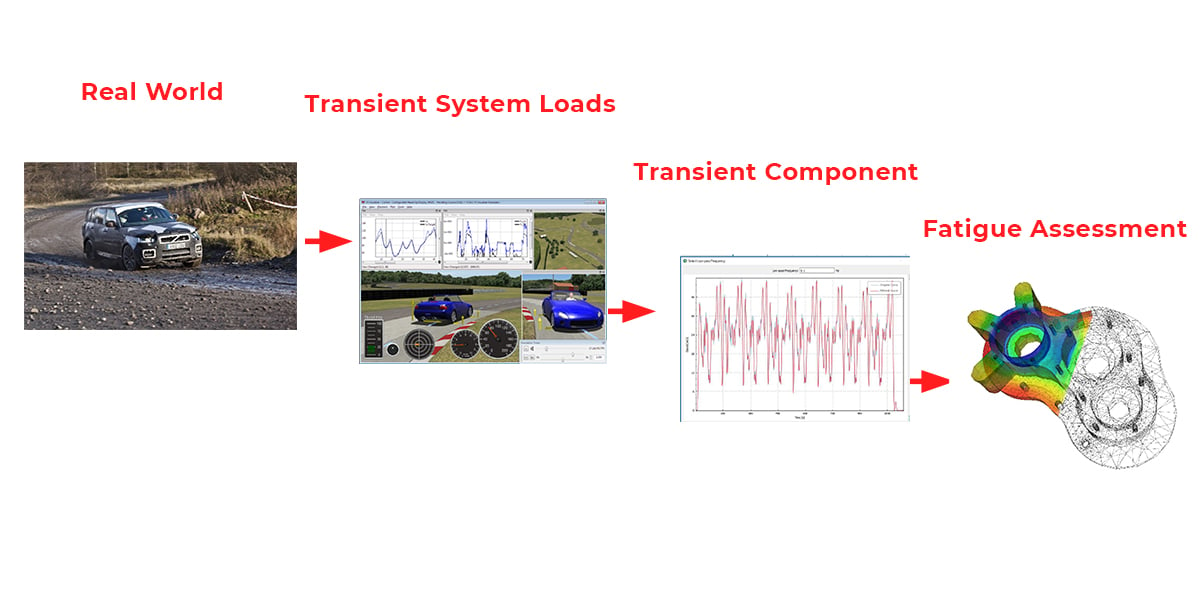Introduction to Thermal Fatigue
Repeated mechanical or thermal stresses can cause fatigue. It is well understood that mechanical systems fail when loads exceed the material yield stress, and vehicles experience this kind of failure when overloaded, hitting severe potholes, or crashing into objects. However, less intuitive is the insidious effect of repeated loading far below the yield stress levels: fatigue. The second source of fatigue worth discussing is the periodic stress from thermal cycling or thermal fatigue. Thermal expansion of high-temperature areas distorts components like heat shields and can lead to fatigue as predictably as engine vibration or other mechanical loads.
This blog will cover an industry-standard workflow to evaluate thermal fatigue and demonstrate that Thermal Fatigue Analysis begins with accurately predicting transient temperature distribution. Because TAITherm is the worldwide leading software for transient thermal simulation, it is the critical enabling technology in accurately predicting thermal fatigue.
Fig 1: Fatigue failure vs. mechanical static overload failure

Fatigue Analysis Background
Fatigue, by its very definition, takes time to occur, so the "cost" of physical testing can be high waiting for repeated thermal or mechanical loads to propagate defects. Overloading a part in a bench test rig can be performed quickly - the overload test usually takes a little time to complete once the fixtures are in place.
In automotive product assurance testing, riding on the so-called "Belgian Blocks" segments of vehicle test tracks imposes severe vibration on test vehicles to fatigue and age them rapidly, equating to 100,000 miles of "normal user" wear in only a few thousand miles. However powerful they are, the blocks cannot accelerate the second source of fatigue: periodic stress from thermal cycling or thermal fatigue. For that, we need a different toolkit.
Thermal Fatigue Analysis
The thermal equivalent of the Belgian Block's mechanical abuse is a robust fatigue simulation workflow or a costly test rig for each automotive subsystem, often placed within an equally expensive environmental chamber. These virtual or physical special testing rigs impose significant gradients in temperature distribution, usually corresponding to 95th-percentile driving profile use cases.
It's generally not a uniform rise/fall of a part's temperature but rather the nonuniformity of the temperature distribution across the part geometry that induces significant mechanical stress. Parts expand in hot areas or contract in cold regions, and this distortion results in stress/strain. Repeat this shifting temperature profile, and you have the recipe for thermally-induced fatigue.
Determining Maximum Gradient
Bearing this in mind, we seek to establish thermal loads and, where possible, validate our thermal model against known test results. For example, we can take a vehicle hill-climb, hot soak test, and evaluate the maximum gradient across crucial components. This temperature distribution is then exported as geometry with temperatures into an external fatigue analysis tool, such as FEMFat, Abaqus, or Hyperlife.
Figure 2: The thermal expansion of the high-temperature areas distorts the heat shield and can predict fatigue as predictably as engine vibration or other mechanical loads.

Predicting Thermally-Induced Fatigue
The fundamental physics of fatigue are well known, and we won't cover them here, except to say that a part often has micro-cracks or casting porosity that acts as stress concentration areas. These imperfections are subject to growth via the cycling of thermal-mechanical loads.
Thermal cycling requires transient modeling because the max temperatures often occur during hot soak conditions. If you are using steady-state predictions, you may be underpredicting max temperature. TAITherm is the global leader in high accuracy and long-transient thermal modeling.
Figure 3: Thermal fatigue analysis begins with predicting temperature distribution.

The Value of Temperature Predictions
One helpful principle that engineers often refer to is that even if the exact value of thermally-induced stress is unknown, it is proportional to temperature differences. As such, having an accurate temperature distribution for a design can help us proportionally scale any established strain gauge test data acquired under a different temperature range.
TAITherm can integrate original or 'modified' strain gauge data as a boundary condition and illustrate the impact of what-if scenarios and trade-offs. For example, we might have strain gauge data for a 35C environment. What if it went to 39? Or what if our heat shield's shiny surface was coated with a layer of dried mud, increasing emissivity and adding an insulating layer?
These practical studies are easily carried out with TAITherm. Furthermore, our engineering services team at ThermoAnalytics can help design these studies based on our decades of accumulated experience, delivering both model planning and supporting model development.

Conclusion
Thermal fatigue can be a latent vulnerability in automotive systems, sometimes not detected in rapid physical testing schemes. It can lead to extensive warranty costs and loss of consumer loyalty. Predicting it often requires transient thermal analysis to determine the maximum temperatures for a system or subassembly.
TAITherm is the optimal software for determining these max values due to its superiority in long-transient modeling. Data exchange between TAITherm and FEA or dedicated fatigue modeling software is widely considered the state-of-the-art workflow for efficient thermal fatigue prediction. If you are interested in learning more about how the thermal simulation capabilities of TAITherm can help your team, please feel free to request a live demo of our software.
Visit our website at suppport.thermoanalytics.com for
- FAQs
- Webinars
- Tutorials
Get help from our technical support team:

In this webinar, we demo how to set up your 3D model in TAITherm and use the results to compare various design options. We will show how TAITherm can calculate the EV range based on the power consumption of all energy-consuming devices and efficiently compare various heating & cooling methods to develop a vehicle that accounts for energy usage and occupant comfort.

